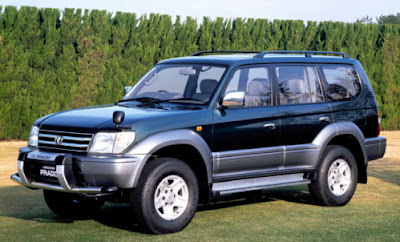Land Cruiser Prado GENERATION {TANZANIA}
Overview
Manufacturer Toyota
Also called
Toyota Land Cruiser (Europe; excluding Gibraltar, Moldova, Ukraine and Russia, and Israel [J120 only])
Toyota Prado (Israel [J90 only])
Lexus GX (North America and Russia)
Production 1984–present
Model years 1985–present
Body and chassis
Class Full-size SUV
Body style 3/5-door SUV
Layout Front-engine, four-wheel-drive
Chronology
Predecessor Toyota Land Cruiser II/Bundera
The Toyota Land Cruiser Prado (Japanese: トヨタ・ランドクルーザー プラド, Toyota Rando-Kurūzā Purado) is a full-size four-wheel drive vehicle in the Land Cruiser range.
It is produced by the Japanese car maker, Toyota. The Prado is one of the smaller vehicles in the range.
From 2009, the Prado is based on Toyota's J150 platform. In some countries it is available as the equivalent Lexus GX.
The Prado may also be referred to as Land Cruiser LC70, LC90, LC120 and LC150 depending on the platform.
In some markets, it is known simply as the Toyota Prado.
In North America, the Prado is not part of the Land Cruiser range; the rebadged Lexus GX occupies the Prado's position in luxury trim.
The GX uses practically identical body panels and V8 engine.
The Prado has ladder frame chassis, two-speed transfer boxes and rear beam axles.
The J70 platform has a front beam axle, while the J90, J120 and J150 platforms have front independent suspension.
As of 2014, the Prado is available in every Toyota market, except the US, Canada (both available as the Lexus GX), Mexico, Brazil and South Korea.
Etymology
The name "Prado" means meadow or field in Spanish and Portuguese.
Toyota Land Cruiser Prado GENERATION {TANZANIA}
Predecessor (J70: 1984)
J70
Toyota Land Cruiser 70 Light 003.JPG
Land Cruiser 70 Light (LJ71G, Japan)
Overview
Production 1984–1990
Powertrain
Engine
2.4 L 22R I4 (petrol)
2.4 L 2L I4 (diesel)
2.4 L 2L-T I4-T (diesel)
Transmission 5-speed manual
Rear view
First developed as the light-duty vehicle of the 70 Series, in November 1984.
Available only in short body with options for soft top or hard top (metal top). Names like Land Cruiser II,
Land Cruiser, and Bundera were made for these "light duty" Land Cruisers.
The Bundera was a short wheelbase—being 2,310 millimetres (90.9 in)—with two doors, a plastic top, and barn doors at the rear.
There were three options for the engine, the 2.4 L (2366 cc) 22R petrol engine and 2.4 L (2446 cc) 2L and 2L-T diesel and turbocharged diesel engines.
Transmission for the petrol engine is the G52 type while the diesels used the R150 and R151 types.
These were the same engines and transmission used in 4Runner, in cooperation with Hino.
First generation (J70: 1990)
J70
Toyota Land Cruiser Prado 70 001.JPG
Toyota Land Cruiser Prado semi long (LJ78G, Japan)
Overview
Production 1990–1996
Powertrain
Engine
2.4 L 22R-E I4 (petrol)
2.4 L 2L-TE I4-T (diesel)
2.7 L 3RZ-FE I4 (petrol)
2.8 L 3L I4 (diesel)
3.0 L 1KZ-TE I4-T (diesel)
Transmission
4-speed automatic
5-speed manual
Dimensions
Wheelbase 2,730 mm (107.5 in)
Length 4,585 mm (180.5 in)
Width 1,690 mm (66.5 in)
Height 1,885 mm (74.2 in)
Kerb weight 1,890 kg (4,167 lb) (2L-TE)
Rear view
In April 1990, a new type, the Prado, was introduced, with a redesigned front grille, front fenders, engine hood, and head lamps.
At the same time, names like Land Cruiser and Land Cruiser II were still used in other parts of the world besides Japan.
Despite a body-on-frame design making it highly capable off-road, the vehicle was marketed toward on-road use.
In Japan, it came with electronic fuel injection and four speed automatic transmission.
The 2.4 L turbocharged diesel engine with 71 kW (97 PS; 95 hp) and 240 N⋅m (177 lbf⋅ft) high torque unit was installed.
The lineup included 2-door and 4-door versions available in SX, LX or EX (4-door only) grades of trim.
The front suspension was changed to a "shock absorber through spring" design to improve handling.
With the touch of a button you could switch between stages of absorber.
The 22R petrol engine was upgraded to the 22R-E (electronic fuel injection) engine, the diesel engines were replaced by the 2.8 L (2776 cc) 3L engine,
and the 2.4 L (2446 cc) 2L-T turbocharged diesel engine was replaced by the electronically injected 2L-TE turbocharged diesel engine.
In 1993, the 22R-E petrol engine was replaced by the 2.7 L (2693 cc) 3RZ-FE petrol engine and the 2L-TE turbocharged diesel engine was replaced by
the 3.0 L (2982 cc) 1KZ-T turbocharged diesel engine with aluminium cylinder head. The 1KZ-TE was able to reduce NO
x and soot. The dashboard was replaced with a new design with minor changes to suspension, brakes and trim details.
Second generation (J90: 1996)
J90
1998 Toyota Land Cruiser Prado (VZJ95R) GXL 5-door wagon (2011-03-10).jpg
1998 Toyota Land Cruiser Prado GXL 5-door (VZJ95, Australia)
Overview
Also called
Toyota Merú (Venezuela; 3-door)
Production
1996–2002
Assembly
Japan: Tahara, Aichi
Colombia: Envigado (Sofasa)
Body and chassis
Related
BAW XB624
BAW Luba
BAW K625T (pickup truck)
Powertrain
Engine
2.7 L 3RZ-FE I4 (petrol)
2.8 L 3L I4 (diesel)
3.0 L 5L I4 (diesel)
3.0 L 1KZ-TE I4-T (diesel)
3.0 L 1KD-FTV I4-T (diesel)
3.4 L 5VZ-FE V6 (petrol)
Transmission
4-speed automatic
5-speed manual
Dimensions
Wheelbase
2,675 mm (105.3 in) (5-door)
2,370 mm (93.3 in) (3-door)
Length
4,675 mm (184.1 in) (5-door)
4,240 mm (166.9 in) (3-door)
Width 1,820 mm (71.7 in)
Height 1,880 mm (74.0 in)
Kerb weight
5-door:
1,890–1,960 kg (4,170–4,320 lb)
3-door:
1,740 kg (3,840 lb)
1996–1999 Toyota Land Cruiser Prado 2-door 2.7 RX Type S (RZJ90W, Japan)
Toyota Land Cruiser Prado GENERATION {TANZANIA}
1998 Toyota Land Cruiser Prado VX Grande (VZJ95, Australia)
In May 1996, the J70 series underwent a makeover and emerged as the J90 series Prado, an independent series.
The body was lengthened. The design remained medium duty, like the J70.
The front suspension was replaced with an independent design, shared with Tacoma and Hilux Surf, made by Hino.
The J90 was made by Tahara Plant, available as a three-door short wheelbase and five-door long wheelbase version.
In Japan, the 3-door series started with an R in the series ranging from RZ, RX, RS to RJ while the 5-door line-up started with T
in the series ranging from TZ, TX, TS, to TJ. All models came with front double wishbone and 4 linked suspension as well as full-time 4WD.
ABS and a Field Monitor showing altimeter, thermometer and pressure were standard in all the models.
The field monitor was not available as standard equipment in South Africa. Television display and audio set was optional.
Petrol engines included the 2.7 L (2693 cc) 3RZ-FE and, new in Prado models, the 3.4 L (3378 cc) V6 5VZ-FE.
Diesel engines were the 2.8 L (2776 cc) 3L engine, the 3.0 L (2986 cc) 5L engine and the 3.0 L (2982 cc) 1KZ-TE.
There was also a luxury version of the J90, called the Challenger.
Features of the Challenger are standard leather seats and wood on the dash.
By June 1999, minor changes were made. In order to follow new laws, fog-lamps were added to the bumper, except in South Africa.
To reduce theft, an engine immobilizer was available.
TX Limited with 8 seats used TX base with roof rail, rear under mirror, wood panel finish, armrest, optitron meter, base cooling as well as rear heater was
introduced into this series.
In July 2000, Toyota introduced the 1KD-FTV 3.0 turbo diesel with D-4D technology to replace the 1KZ-TE in Japan.
The Prado was assembled by Sofasa in Colombia from 1999 until 2009 without significant changes. There were two versions, a 3-door with
a 2.7 L engine and 5-door with a 3.4 L V6 engine with either a 5-speed manual or a 4-speed automatic.
Between 2005 and 2009 they offered an optional armoured version of the 5-door version.
When the Prado was launched in the UK in 1996, it was called the Land Cruiser Colorado and replaced the 4Runner, which had been discontinued from sale.
It was called this to distinguish it from the larger Land Cruiser – renamed as the Land Cruiser Amazon – which was already on sale.
It dropped the Colorado name tag in 2003, when it was renamed simply Land Cruiser.
In the Republic of Ireland most Land Cruisers were sold as commercials with the rear side windows and seats removed for tax reasons.


















No comments:
Post a Comment